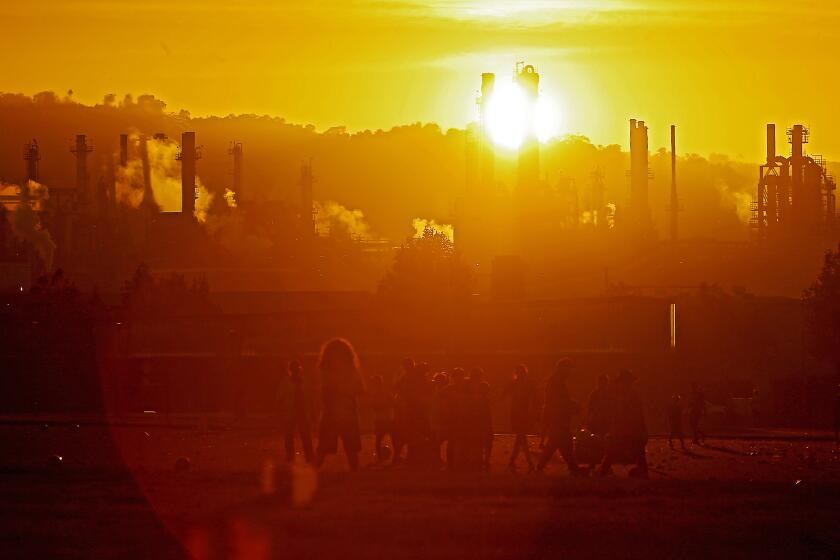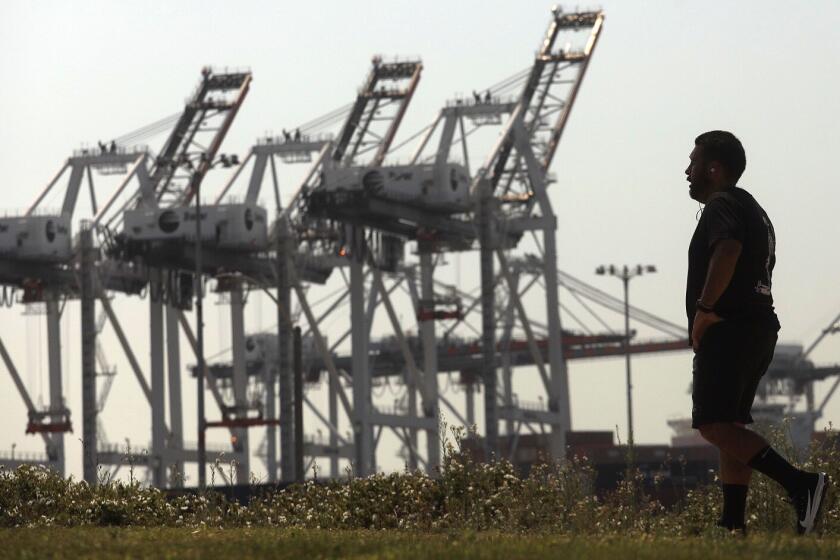California workers shouldn’t have to face another broiling summer without indoor heat protections

- Share via
Seven summers have come and gone since California lawmakers voted to require indoor workplace standards to prevent workers from being injured or killed from extreme heat.
Thanks to ineptitude by state officials, California is heading into another summer without rules to protect the nearly 1 million people who labor inside sweltering warehouses, boiler rooms, kitchens and other facilities.
Under a 2016 law, regulators had until the end of 2018 to submit these long-promised standards to a governor-appointed board for adoption. In facilities where temperatures exceed 82 degrees, the regulations require employers to provide cooldown areas, water and rest breaks to prevent workers from overheating. They also require air conditioning, schedule adjustments or other measures to prevent them from working in temperatures over 87 degrees.
California lawmakers should support the Polluters Pay Climate Cost Recovery Act, a Superfund-style bill that would force big fossil fuel companies to pay for their damage to the climate. Otherwise, taxpayers will ultimately foot the entire bill.
These are humane and reasonable measures, and it’s unacceptable that state regulators are so far behind in adopting the rules to make them a reality. Extreme heat is the No. 1 killer among climate hazards, responsible for an estimated 3,900 deaths in California from 2010 to 2019. It’s an increasing threat to workers in fast-growing industries, such as warehousing and logistics, that are concentrated in the Inland Empire and Central Valley.
State officials, including Gov. Gavin Newsom, whose office recently boasted that no other governor has done as much to protect people from extreme heat, should be ashamed. Oregon became the first state to adopt heat protection rules for indoor workers in 2022, just 10 months after the devastating and deadly heat dome the year before.
The planet has recorded 10 straight months of record-high temperates. If world leaders need a jolt to get into crisis mode on climate change, this should be it.
In the spring of 2023, we urged Newsom and his appointees on the Occupational Safety and Health Standards Board to stop plodding along and get these lifesaving protections in place in time for the approaching hot weather months.
They didn’t and hit another roadblock this year: concerns about how much it would cost for state prisons and other correctional facilities to comply with the law.
The California Department of Corrections and Rehabilitation estimates it would take billions of dollars in capital improvements to cool the state prisons and other facilities in which its tens of thousands of employees work. The department refused to provide details or documentation of why it would cost so much to keep its workers cool and safe.
The costs to state prisons are a poor excuse to further delay measures that are expected to save lives and prevent illness and injuries. At a public hearing in March, Cal/OSHA board members heard emotional testimony from workers and labor representatives about employees passing out and in some cases dying from suffocating conditions inside commercial kitchens, laundry facilities and fast-food restaurants.
President Biden’s tariffs on Chinese-made electric vehicles and batteries will hurt consumers and slow the transition to zero-emission vehicles at a time when the U.S. needs to rapidly reduce its reliance on fossil fuels.
The board at least put worker safety over politics by voting to adopt the rules even after the Newsom administration raised objections about the cost. But it wasn’t enough because the rules still need approval from the Department of Finance.
There’s still hope that the heat standards can be put into place to help most of the state’s workers this summer. Cal/OSHA has submitted a revised proposal to exempt state and local correctional facilities that will go to the board for a vote in June (and plans to create separate rules for corrections later).
Southern California air quality officials discussed port pollution at a luxury Rancho Mirage resort 100 miles from the harbor, when they should be adopting long-delaying rules for L.A. and Long Beach ports to slash health-damaging emissions.
But the state’s seesawing on the heat standards has opened them up to challenge from business groups, which have seized on the delay to attack the process, highlight their own costs and question why they aren’t also getting exemptions.
State leaders still seem to be treating extreme heat like a low-priority concern, rather than the increasingly deadly hazard it is. Programs to respond to extreme heat, for instance, are among the billions in climate-related cuts Newsom and lawmakers are planning to deal with a $45-billion budget deficit.
Officials say they are on track to have the indoor heat standards in place sometime this summer. Let’s hope so.
Intramural bureaucratic disputes do nothing to help those toiling in oppressive heat on a daily basis with no guarantee of water, cooling, rest breaks and other basic health and safety precautions. Each month that passes without these standards is an ongoing injustice and a black mark on Newsom’s labor and climate record.
More to Read
A cure for the common opinion
Get thought-provoking perspectives with our weekly newsletter.
You may occasionally receive promotional content from the Los Angeles Times.













